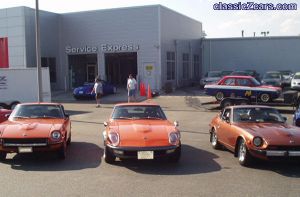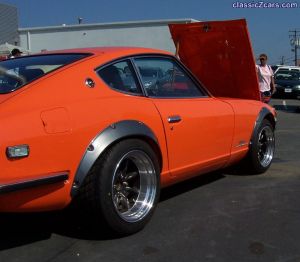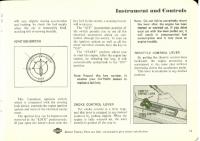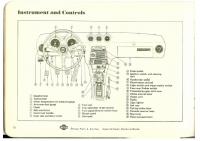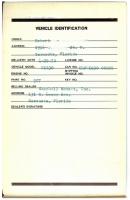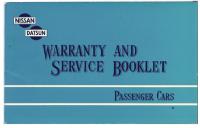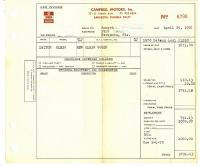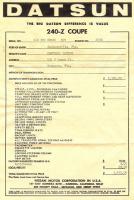Everything posted by 26th-Z
-
Philosophical discusion on build dates
More great information. Great discussion. Thanks for the pictures, kats.
-
Philosophical discusion on build dates
There is some discussion crossover between this thread and the "round knob - square knob" thread about the hand throttle. It appears as though we can "date" cars buy the parts they do or don't have and dated service bulletins. Kats, do you have a complete set of bulletins from the first year? Although I have heard of the change to the crankshaft, I have never seen a complete description like your photo. Also to reminisce for a moment, I recall discussions about the BRE 240Z raced in SCCA competition to the C-Production National Championship. BRE had horrible difficulties with broken crankshafts initially, and when they finally got the car to last (and win), everyone thought they were "cheating" with some special "roller bearing" crankshaft. It was all in the harmonics and balance of the new design. The bulletins kats posted tie dates to VIN numbers and engine numbers. Proabably the most definitive connection we have established so far. Kats, Hosomi san sends greetings and has glowing remarks about your car. Chris
-
Location of the ZG cars?
That converts to $16,000 and it appears as though the car was originally GP White. Nice ride.
-
How many manufactures can you list up?
kats, Hitachi mark on the antenna trim !!!! Too much !!!! I love it !!!!
-
Show line
-
G-nose rear quarter view
-
round shape knobs and square shape knobs
No, they all had air pumps (agreed) and all that garbage. I believe the fuel mixtures, timing advance, and ignitions were adjusted to different settings if memory serves me correctly. Fewer hydrocarbons to tarnish all that silicone in the valley, evidently. A few cars were imported without the fuel vapor recovery system and mine is an example. The gas tank does not have the fittings for all the hoses. I am not going to restore the emissions hardware to my car. I just can't force myself to do it. Please forgive me, it's an issue I have with my addiction to sports cars. Instead, I have the proper Datsun parts to replicate the non-emission engine.
-
round shape knobs and square shape knobs
California has tougher emmissions standards, Andrew.
-
round shape knobs and square shape knobs
Thanks kats. :classic:
-
original jute material
I'll have to do some research, but to the best of my knowledge, the vinyl is glued directly to the rear bulkhead behind the tool boxes and seats. I have a piece of black - used. Do you want it?
-
Location of the ZG cars?
I have no production figures for the ZG, Ben. But I can confirm 420 examples of the Z 432 from my literature. 299 were built in 1970 and interstingly, although not listed as available, 23 examples of the Z 432 were produced in 1972 and 1973. My source is Brian Long. I'm surprised Alan T. hasn't come in on this. He has a beautiful car in the unique maroon color. Alan?
-
Location of the ZG cars?
Nissan Datsun announced changes in their lineup in October 1971. The 2.4 liter engine was introduced to the home market, but the most significant change was dropping the Z 432 model and introducing the ZG model - designation HS30H. ZGs were produced through September 1973. The combination of the S20 engine with the Z chassis was not particularly good for road use and Nissan wanted to homologate a number of items for racing purposes. The G stands for "Grand". The ZG nose added 190mm to the overall length of the car and the rivit attached overfenders added 60mm in width. Top speed was classified as 128 mph - 3 mph faster than the standard Z model. It came with the L24 engine - 150bhp, 5 speed transmission and 3.9:1 final drive. A three speed automatic was also available. You could get the car in any color you wanted as long as it was red, white or maroon. The maroon color is exclusive to the ZG. As far as I know, the ZG was intended for the Japanese home market and was not exported. I may get corrected on this one, but all the examples outside Japan were privately imported from Japan. With that short introduction, I'll stand aside and let the resident experts respond. :classic:
-
Works racing wheel wanted
I might also butt into this conversation with the idea of the liability involved in producing a wheel - should it ever break. Casting a replica or set of replicas might be a fun project and the wheels would make a great addition to anyone's dream garage as a conversation piece. I would imagine a set could be used for display purposes and rolling a car around at a show without much concern for safety. They would need to structurally withstand mounting and inflating a tire. In terms of expense for the real thing, I might suggest comparing them with the current pricing of a performance wheel such as a BBS. Unless I was restoring an authentic car, I think I would gasp! My 2 cents - Thanks
-
round shape knobs and square shape knobs
Great, kats Thanks.
-
Philosophical discusion on build dates
Yes I did! I know several of the people involved with the sale of the car, originally. I bought the car from the estate of the original owner and remember it from new as it belonged to the father of a good friend of mine. The original salesman and one of the mechanics for Campbell Motors are still alive. They tell me that way back then, they didn't really know what the car was. It was the first 240 Z in Sarasota and there is some debate about this, but the first one in Florida - perhaps. An interesting little "typo", isn't it? Campbell had just added the Datsun line to the dealership. They sold Simcas and Sunbeams. Mr. Campbell didn't want to deliver the car right away. He wanted to have the car in his showroom for a few weeks. I have the reciepts for the payments and even though the car was sold in April, it wasn't fully paid for or delivered until May. I posted pictures in the "hand throttle" thread from my owner's manual and interestingly between 20 December 1969 and 15 January 1970 the manuals were hand edited to delete the feature from the literature. Also note the carpeting feature listed on the shipping bill. That paper would have been used as what we call the window sticker. Some time ago, we discussed whether or not the original 240 Zs came with carpeting or rubber floor mats. The literature also shows Nissan having USA main land distributors in California and New Jersey. My shipping bill shows Jacksonville as the port of entry, indicating a couple of things. First, Her Majesty probably saw the Pananma Canal. But the extra time it took to get to the East coast might explain the November manufacture date stamped on the door jamb. Alan has proposed that the stampings were not done at the factory, but rather (where did you say, Alan?) casting doubt on the accuracy of the door jamb plates. This could explain why my lower serial number car has a later manufacturing date than later serial number cars. 26 may have been on a different boat than 42. What might be possible is to research the shipping records for information about what was shipped where and when.
-
240Z Series 1 Tool Box Questions
Yes, I have one of those.
-
round shape knobs and square shape knobs
Is there a date on your manual, Andrew? There are pictures of my manual covers in my gallery - page 3. 20 December 1969 It would be interesting to know when Nissan did that to the manuals. I swear if I look at the knobs on page 10 with a magnifying glass, they are the square shape. But all the rest of the drawings show rounded - clearly. Would love to see what you find, Mark.
-
round shape knobs and square shape knobs
I hope you guys take this club and the discussions we have with as much pleasure, fun and sense of humor that I do. I try not to offend anyone. :classic: These little faces really do help. Mike, you make a good point. Now that I look at all the various pictures (hand drawings) of the hand throttle and choke knobs scattered throughout the manual, I notice them pointing in opposite directions, square, and rounded. I am impressed with how well the drawings depict actual parts, but it is difficult to say what is absolutely correct. The knobs shown on page 10 of my manual look square. On pages 13 and 15, they point left. On pages 16 and 17, they point in opposite directions! Mark and Andrew, do I understand correctly that your manuals were "edited" with paste-overs deleting the hand throttle feature?
-
round shape knobs and square shape knobs
I was just poking fun, Ben. I can't tell you how surprised I was to find the mention in the owner's manual. We had almost come to the conclusion that the hand throttle was excluded from the American market with the exception of a few cars that "snuck" in. Evidently not so.
-
round shape knobs and square shape knobs
Why do both knobs point to the left? Perhaps evidence that the car was orignally designed for LHD American export?
-
round shape knobs and square shape knobs
I found this in my 1969 Owner's manual - two pages discussing the throttle controls. Notice the round shape of the knobs.
-
Philosophical discusion on build dates
Information is typed inside the front cover. This was a 12 month / 12,000 mile warranty and the tires and battery were covered seperately from the manufacturer. The pages are tear-aways for service intervals and the first few are missing from my book, but the later pages up to 36,000 miles are still there.
-
Philosophical discusion on build dates
Everyone, When this thread started, I got my paperwork out and while looking at it, discovered some great stuff relating to several threads we have had in the past. Throttle controls on the early cars, rear-view mirror types, seatbelts, original tire specifications, and many other things are shown in the owner's manual and would clear up many questions. I will try to go back and find those threads so that I can post pictures of my information. Should be fun! Kats, since you are going to the convention in June, I will bring this information with me to show you. This is the cover of the Warranty and Service Book for my car.
-
Philosophical discusion on build dates
This is the Bill of Sale for my car. I erased the names on the .jpg file for privacy reasons, but everything else is original.
-
Philosophical discusion on build dates
Hi kats, Photographs of my Owner's Manual are in my gallery - page 3. You will notice the printing date of the manual - 20 December, 1969. This is the shipping bill fo my car. I keep these papers safe in a bank. Probably safer than the car!





